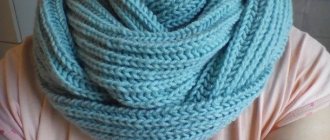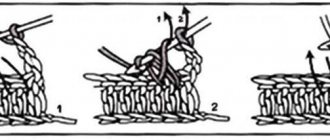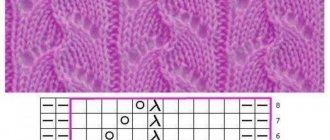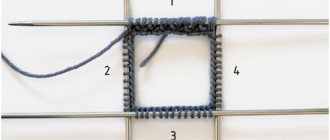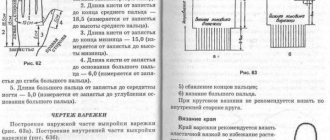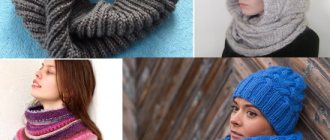Short description
The original men's knitted vest is a practical and comfortable sleeveless garment that can be safely worn over a shirt, golf or sweater. Depending on your body type and personal preferences, you can knit a fitted, semi-fitted, straight, long or short model. The main advantage of such clothing is that it goes well with almost all styles and looks. A sleeveless vest knitted from high-quality yarn is most suitable for cool autumn evenings and cold winters. In addition, many women often decide to knit a vest as a gift for their beloved man.
It is also worth considering that there is one big difference between men's vests and sleeveless vests - the number of parts. The vests consist of two shelves and a back, and are also equipped with a special fastener.
But sleeveless vests only include the back and front.
Varieties of knitted patterns
Deciding on a style can be as difficult as choosing the right threads. A men's knitted vest can be made with any neckline, with or without buttons. All this will depend on the wishes of the person. In addition, on the Internet you can find various patterns and descriptions of a men's vest, knitted with knitting needles.
If the model is knitted for the cold season , then it is worth using wool or wool blend threads. A model knitted from woolen threads is primarily intended for insulation, so it must provide warmth.
Plain cotton threads are used for a sleeveless vest that will be worn on cool summer evenings, as well as in spring and fall. It can be knitted in any pattern that a man chooses. This vest can be used to decorate an evening outfit in cool weather.
The neckline can be either round, square or V-shaped. Many men prefer the latter neckline option - this is worth paying attention to.
Types of sleeveless vests
Over the past few years, the leading position has been occupied by the vest model that was made in elementary stocking stitch. The secret of such a product is that the front rows of all parts are connected to each other by facial loops. The cut in this case can be completely different:
- Necks with a small collar or in the shape of a miniature toe.
- The main part of the front part is divided into two shelves or solid.
- The planks are tied together with a neat braid, a small elastic band or other pattern.
These options are often chosen by beginning craftswomen, because making mistakes in this case is quite difficult.
Vest pattern
All models of vests for men have almost the same pattern. They may differ in neckline and armhole depth - these are details. Let's look at the shooting with a description for beginners.
Let's look at the most important measurements that need to be taken from a man when creating a vest.
The product only requires a couple of measurements:
- back length;
- hip circumference;
- shoulder width;
- neck circumference;
- height to sleeve armhole.
After measuring the indicators, you need to transfer them to a small plan. You will get a drawing like this.
In this case, the circumference of the hips turned out to be 100. Without any additions to the seams, they transferred it to the drawing. For half of the vest it will be 50 cm. So with each size. But for the height of the back, you need to add another cm to the elastic band and, if desired, lengthen the vest a little.
Selection of yarn and knitting needles
Experienced craftswomen always note that a men's vest knitted with knitting needles should be equipped with button fasteners. That is why it is better to select 6-7 small buttons in advance that will match the main color of the selected yarn. In order for the final result of the work done to fully meet all the requirements, you must first knit the sample. It is from this that it will be possible to calculate the required number of loops that will need to be cast to make a vest of the required size. In addition, information is always indicated on the yarn, thanks to which you can calculate the approximate consumption of the thread used.
It is worth noting that it is much easier for beginning craftswomen to work with Lanagold yarn . Such indicators are due to the fact that its composition contains 51% acrylic and 49% wool.
As for the choice of knitting needles, it all depends solely on what pattern needs to be made and the number of yarn used. No less important is the density of knitting, which is absolutely individual for each needlewoman. This is due to the fact that during operation different intensity of thread tension is used. Because of this, sewing the same item may require different amounts of yarn.
When the yarn number is selected, then you can safely select the most suitable knitting needle size. In this case, it is important to note that the thickness of the thread should not exceed the thickness of the knitting needles used.
Many craftswomen prefer to knit several samples of yarn in advance, which should be made with knitting needles of different thicknesses. It is from these samples that you can choose the most suitable option.
Knitted vest "Zigzags" with buttons
Knitted men's vest "Zigzags" with buttons
A vest is a universal basic item that should be in every man’s wardrobe. We present to your attention an elegant men's vest with buttons, knitted from thick ash-green wool blend yarn. The classic sleeveless model is made with a simple zigzag pattern of only front and back loops, but it looks very beautiful and dignified. Classics are always in trend. Sizes: 52 (54) 56 - Russian; XL (2XL) 3XL - international; 40-42 (42-44) 46-48 - European. Measurements: chest girth - 103-106 (107-110) 111-114 cm; waist circumference - 91-94 (95-98) 99-102 cm; hip girth ‒ 106-108 (110-112) 114-116 cm. Required: 400 (420) 450 g of Hamanaka “Men's club master” yarn (60% wool, 40% acrylic, 75 m/50 g) - color No. 50 (ash green);
knitting needles No. 4.5, No. 5 and No. 5.5; buttons (diameter 2 cm) - 6 pcs. Abbreviations: p. = loop; persons = knit (loop); purl = purl (loop); chrome = edge (loop). Rib 1x1: knit 1 knit alternately in the front rows. and 1 purl., in the purl rows of loops, knit according to the pattern. Garter stitch: knit stitches in all rows. Zigzag pattern (rapport = 10 stitches): knit front and back rows according to the pattern. In the diagram, the back rows are shown as they look from the front side. Perform 1 time from the 1st to the 4th row, then repeat from the 5th to the 20th row. Decreasing stitches along the edge of the fabric: on the right side - knit the first 2 stitches together with the front one behind the back walls (tilt to the left); on the left side - knit the last 2 sts together behind the front walls (tilt to the right). The loops reduced in this way can then be easily and quickly raised to knit the strap. Knitting density: 17.5 loops and 22 rows = 10 x 10 cm. This is important! When reading the description, pay attention to the numbers in […] square brackets - this is the total number of loops that should be obtained after decreasing or adding loops.
※Back
On knitting needles No. 5, cast on 91 (95) 99 sts and for the bottom bar (1.5 cm = 4 rows), first knit 1 knit row with knit stitches, then 3 rows with 1x1 rib, starting after 1 edge. from 1 person (1 purl) 1 purl Switch to knitting needles No. 5.5 and continue knitting from the 5th row with the Zigzag pattern, distributing the loops as follows: 1 edge; 4 (1) 3 sts before rapport; Repeat 10 points of rapport 8 (9) 9 times; 5 (2) 4 p. after rapport; 1 chrome At a height of 33.5 (34.5) 35.5 cm = 74 (76) 78 rows from the bottom bar for the armholes on both sides, close 5 (6) 6 loops, then in each 2nd row decrease 2 times 2 p. and 3 times 1 p., then in the 4th row - 1 time 1 p. [= 65 (67) 71 p.] At a height of 24.5 (24.5) 25.5 cm = 54 ( 54) 56 rows from the beginning of the armholes for the neckline, close the middle 23 (23) 25 sts and on both sides of them decrease in the 2nd row 1 time, 3 sts each. Finish each side separately. At a total height of 61.5 (62.5) 64.5 cm = 136 (138) 142 rows, close off 18 (19) 20 stitches on each shoulder .
※ Left shelf
On knitting needles No. 5, cast on 46 (48) 50 sts and for the bottom bar (1.5 cm = 4 rows), first knit 1 knit row with knit stitches, then 3 rows with 1x1 rib, starting after 1 edge. from 1 person Switch to knitting needles No. 5.5 and continue knitting from the 5th row with the Zigzag pattern, distributing the loops as follows: 1 edge; 0 (2) 4 sts before rapport; Repeat 10 points of rapport 4 times; 4 p. after rapport; 1 chrome At a height of 32.5 (34.5) 33.5 cm = 72 (72) 74 rows from the bottom bar to bevel the neckline on the left side, close 1 p., then in every 4th row decrease 14 (14) 15 times 1 p. At a height of 33.5 (34.5) 35.5 cm = 74 (76) 78 rows from the bottom bar for the armhole on the right side, close 5 (6) 6 loops, then in every 2nd row decrease 2 times 2 p. and 3 times 1 p., then in the 4th row - 1 time 1 p., while continuing to bevel the neckline. At a total height of 61.5 (62.5) 64.5 cm = 136 (138) 142 rows, close off 18 (19) 20 sts of the left shoulder .
※ Right shelf
Knit symmetrically to the left front.
On knitting needles No. 5, cast on 46 (48) 50 sts and for the bottom bar (1.5 cm = 4 rows), first knit 1 knit row with knit stitches, then 3 rows with 1x1 rib, starting after 1 edge. from 1 person Switch to knitting needles No. 5.5 and continue knitting from the 5th row with the Zigzag pattern, distributing the loops as follows: 1 edge; 4 sts before rapport; Repeat 10 points of rapport 4 times; 0 (2) 4 p. after rapport; 1 chrome At a height of 32.5 (34.5) 33.5 cm = 72 (72) 74 rows from the bottom bar to bevel the neckline on the right side, close 1 p., then in every 4th row decrease 14 (14) 15 times 1 p. At a height of 33.5 (34.5) 35.5 cm = 74 (76) 78 rows from the bottom bar for the armhole on the left side, close 5 (6) 6 loops, then in every 2nd row decrease 2 times 2 p. and 3 times 1 p., then in the 4th row - 1 time 1 p., while continuing to bevel the neckline. At a total height of 61.5 (62.5) 64.5 cm = 136 (138) 142 rows, close off 18 (19) 20 sts on the right shoulder .
※ Assembly
1. Moisten the finished parts of the vest, straighten them and let them dry. 2. Sew shoulder seams. 3. Using knitting needles No. 4.5 from the wrong side along the edge of the product, raise: 60 (60) 62 sts of the left front to the bevel + 50 (52) 54 sts of the bevel of the left front + 31 (33) 33 sts of the back neck + 50 (52) 54 sts of the right front bevel + 60 (60) 62 sts of the right front after the bevel = 251 (257) 265 sts. Knit 2.5 cm = 8 rows in garter stitch (1st row - knit stitches). On the left fastener bar in the 5th row, evenly make 6 holes for buttons (2 stitches together + 1 yarn over). The first hole is at a distance of 4 (4) 5 p. from the bottom edge, the remaining 5 holes are at intervals of 10 p. Then loosely close all the loops by knitting them. 4. Along the edges of the armholes from the front side on knitting needles No. 5, pick up 106 (108) 112 sts, knit 1.5 cm = 4 rows with a 1x1 elastic band and bind off the loops in an elastic way. 5. Sew side seams. 6. Sew buttons.
※ Useful tips
● For ease of knitting, print out the pattern of the product and circle the selected size. ● At the beginning and end of knitting each part of the product, it is advisable to leave a sufficient end of the working thread so that it can later be used when assembling (connecting) the parts. ● It is advisable to join the knitted parts of the product using a knitted seam. ● Knitted items should be washed in moderately warm water using special detergents. Soak for 3 minutes, squeeze several times (but do not rub), then rinse thoroughly in cool water and squeeze lightly. Do not twist while spinning! Wrap in a terry towel and squeeze again. Then straighten it and lay it out on a flat surface, preferably on a thick fabric that allows air to pass through well. ● Do not iron or steam the knitted product, so as not to disturb the relief of the pattern and the elasticity of the knitted elastic band! ● Raised patterns are great for smooth yarns such as cotton, cotton rayon, silk or linen blends. If the yarn is thick, the pattern looks especially prominent. If the yarn is thin, you will get a refined, noble structure.
※ Pattern diagram
※ Pattern
All sizes are indicated in centimeters.
ஓજஓજஓ
All rights reserved. Copying material for publication on other sites is prohibited! It is allowed to use an announcement with a picture if there is an active link to the source ladies.by
ஓજஓજஓ
You may be interested in other sections: Knitted patterns for men Knitted patterns for women Knitting for boys Knitting for girls Knitting for kids under 2 years old Knitted toys Amigurumi art Knitting for the home Knitting for dogs Collection of knitting patterns Collection of crochet patterns Knitting lessons Crocheting lessons Knitting ‒ portable hobby
If you found the page interesting and useful or have something to share, please leave your comment. We will be very grateful to you. ☸ڿڰۣ–
Classic model
Recently, more and more craftswomen are deciding to knit a men's vest with knitting needles. The diagrams and description of this process are quite simple, especially if you already have relevant experience. To sew a classic vest you need to follow a few simple steps:
- We take knitting needles No. 3.5, cast on 123 loops and knit 7 cm with an elastic band (1 loop should be front, 1 purl).
- Now you need to take needles No. 4 and continue knitting the pattern according to the pattern. In one purl row you should add no more than 8 loops, for a total of 131.
- On both sides for the armholes at a distance of 40 cm we close off 4 loops (this procedure is carried out until 99 loops are released).
- Under each shoulder at a height of 70 cm, be sure to close 28 loops. To form the neck, 43 loops are allocated.
- The front part is knitted according to the same pattern as the back. But at a height of 42 cm you need to make a V-shaped neckline cutout. For the result to exceed all expectations, you need to close the middle loop and knit both sides separately. Every other row, decrease along the inner edge 20 times, 1 stitch at a time. At a height of 68 cm, we close 28 loops for each shoulder.
- At this stage, you can safely begin assembling the vest. Each detail must be glued to the pattern and slightly moistened. The product must be allowed to dry. Now you can sew one shoulder.
- Again we take knitting needles No. 3.5 to pick up all the stitches along the edge of the neckline. We outline a corner loop and knit with an elastic band (1x1). In this case, in each paired row on both sides we decrease one loop 6 times.
- We knit another 10 rows and close the loops according to the pattern.
- Gradually sew the second shoulder. Along the edges of the armholes, be sure to lift the loops using knitting needles No. 3.5. We knit another 6 cm with a 1x1 elastic band. Only after this will it be possible to close the loops according to the pattern.
- We perform all side seams.
After this, self-knitting a vest for a man can be considered complete .
knitting patterns and descriptions with photographs, video tutorials
A sleeveless vest should be in the wardrobe of every person, be it a child, a teenager, a woman or a man. All the more useful is a strict and elegant vest, in which a man can even appear at a business meeting. And a sleeveless vest, knitted with your own hands for your beloved man, will definitely become an important part of your wardrobe. That is why the next master class is dedicated specifically to the men's sleeveless vest.
Option 1 (the simplest)
This knitted men's sleeveless vest, the patterns and description of which are given below, will appeal to every man.
For sizes 52 – 54 you need:
- Yarn - 600 g;
- Knitting needles number 4.
The knitting density should be 20 p = 10 cm.
How to knit a men's sleeveless vest with knitting needles, see below.
Detailed description with photos
For the back:
Cast on and knit with an elastic band 1 through 1 110 sts 6 cm. Add 12 sts in the next row, for a total of 122 sts, knit according to the pattern.
Having knitted 49 cm, you need to close 4 sts on the sides for the shoulder bevels, then in each 2nd row decrease 3 sts, 2 sts and 1 st. Having knitted 25 cm from the beginning of the bevels, close 34 sts along the edges for each shoulder, and remove the remaining central 34 sts onto an auxiliary needle.
For the front:
The front needs to be knitted like the back, only for a V-shaped neckline you need to remove 2 middle sts at a height of 49 cm onto an auxiliary needle and decrease both parts 17 times, 1 st in each 4 r. When the height of the fabric is 74 cm, you need to close 34 stitches for each shoulder.
The master class “knitting sleeveless vests for men” is coming to an end, all that remains is to put all the details together.
Assembly:
Make 1 shoulder seam. Raise all neck loops onto knitting needles and knit 8 rows. with an elastic band., while decreasing every other row by 1 p. from 2 central loops. Close all the loops according to the pattern.
Sew 2 shoulder seams and binding.
Along the edges of the bevels, cast on all the loops on the knitting needles and knit with an elastic band 1 through 1 6 rows. Close off all the loops according to the pattern and sew along the remaining seams.
More details in the video:
Option 2: conservative style
You can knit a slightly different sleeveless vest, for example, this conservative model.
What is necessary:
- Acrylic yarn 300 g;
- Knitting needles number 4.
Detailed description
For the back:
Cast on 123 sts and knit 7cm. rubber band 1 through 1.
Next, knit according to the pattern, adding 8 stitches in 1 purl row. The number of loops should be 131.
Having knitted 40 cm, close off 4 stitches on both sides for the shoulder bevels, and after 1 row. decrease 3 p., 3 times - 2 p., 3 times - 1 p. Decrease until 99 p. remain.
When the height is 68 cm, you need to close 28 sts under each shoulder, 43 sts for the neck.
For the front:
Knit similarly to the back, but knit 42 cm. Make a V-shaped neckline. To do this, close the middle loop, and in each 2 r. For each resulting side from the neck side, decrease 1 p. 21 times. Bind off 28 stitches for each shoulder at a height of 68 cm.
Assembly:
Place all the details on the pattern, moisten it a little and wait until it dries completely. Sew 1 shoulder.
Raise all the loops along the edge of the neckline, mark a corner loop and knit with an elastic band 1 through 1, while decreasing 1 stitch 5 times in each 2nd row.
Knit 10 rows, then close the loops according to the pattern.
Sew 2nd shoulder. Raise all the loops along the edges of the bevels and knit 4 cm with an elastic band 1 through 1, close all the loops according to the pattern.
That's it, the sleeveless vest is ready. You can safely give it to your chosen one.
webdiana.ru
A sophisticated product
Many representatives of the stronger sex, who often attend business events, increasingly prefer a knitted men's sleeveless vest. Schemes and descriptions of making such clothes are distinguished by their versatility, because the final item will definitely turn out neat and unobtrusive. The presented model is most suitable for those men who wear clothes of sizes 52-54.
First of all, you need to knit the back. We cast on 110 loops and knit with an elastic band of 6 centimeters one after another. In the next row you need to add 12 stitches to make 122 stitches. Only when the craftswoman has knitted at least 49 centimeters of the product will it be possible to close the loops for the shoulder bevel. Initially, 4 pieces each, and then in every second row you should decrease three, two and one loop. Having knitted 25 cm, we close 34 loops along the edges from the beginning of the bevel. As a result, 34 central loops should remain, which must be removed on an additional knitting needle.
diagrams and descriptions of clothing for men with photos and videos
A sleeveless vest should definitely be in a real man's wardrobe. Particular preference is given to strict options, and even if the product is knitted by hand, it is especially valuable to a strong representative of humanity. It would be useful for needlewomen to learn how to knit a men's sleeveless vest, the diagrams and descriptions of which will be very useful in their work.
Model number one
Any man will like this stylish sleeveless vest. This model is especially interesting, because a knitted sleeveless vest for men will be very practical to wear.
You need yarn and knitting needles. Consider size fifty-two to fifty-four. We start work by knitting the back. Cast on one hundred and ten loops and knit six centimeters with an elastic band one after another. In the next row, add one hundred and twelve stitches. The result is one hundred and twenty-two loops, which are knitted according to the pattern:
When forty-nine centimeters have already been knitted, you need to close the loops for the shoulder bevel. First, four loops, and then in every second row you need to decrease three, two and one loop. Having knitted twenty-five centimeters, from the beginning of the bevel we close thirty-four loops along the edges, and the thirty-four central ones that remain must be removed on an additional knitting needle.
The front is knitted similarly to the back, only the neckline will be a toe. For it, at a height of nine centimeters, we remove the two middle loops and decrease both parts seventeen times, one loop in every fourth row. At a height of seventy-four centimeters we close off thirty-four loops for each shoulder.
The knitting is almost finished, all that remains is to assemble the parts of the product.
We make one shoulder seam. Raise all the throat loops onto a knitting needle and knit eight rows with an elastic band. Decrease one stitch at a time from the two center stitches. Close the loops according to the scheme:
Sew along the shoulder seams and also the binding. Along the edges of the bevels, put all the loops on a knitting needle and knit with an elastic band, face to back, for six rows, then close the loops as shown in the figure. So the craftswomen learned how to knit a men's sleeveless vest!
Second version of the sleeveless vest
This version of the sleeveless vest is very conservative and is suitable even for business meetings. It looks neat and unobtrusive.
For this model you need number four knitting needles and acrylic yarn.
The diagram is attached:
Start the product from the back. Cast on one hundred and twenty-three loops and knit six centimeters with an elastic band. Then knitting proceeds according to the pattern, adding eight loops in one purl row. There should be one hundred and thirty-one loops.
Having knitted about forty centimeters, close four loops on each side and decrease three loops every other row, two loops three times, one loop three times. And in this way make decreases until ninety-nine loops remain. Having knitted to a height of sixty-eight centimeters, you need to close twenty-eight loops for the shoulders, and forty-three loops for the throat.
Before knitting it is similar to the back, but after forty-two centimeters are knitted, we knit the toe of the collar. To do this, the middle loop needs to be closed, and in every second row you need to decrease one loop from the toe side twenty-one times. At a height of sixty-eight centimeters, bind off twenty-eight loops for each shoulder.
Important! Before assembly, the product should be slightly moistened with water and wait until it dries.
Sew one shoulder. Raise the loops along the very edge of the neck, mark a corner loop and knit with an elastic band one on one, while decreasing one loop five times in every second row. And so knit ten rows, then close according to the pattern. Now sew the other shoulder. Along the edges of the bevels, pick up all the loops and knit with an elastic band one by one four centimeters, close all the loops. That's all, a great sleeveless vest is ready!
Interesting option
In some models, needlewomen themselves come up with interesting knitting patterns and then bring them to life.
Our material will present another version of a men's sleeveless vest.
For the back you need one hundred twenty-six loops, knit seven centimeters with an elastic band. Having knitted thirty-five centimeters, we begin to make an armhole, while closing off ten loops: five once, and then in every second row there are three loops, after which only two. Then knit without decreasing. The neck is knitted at a height of sixty-seven centimeters, forty-two loops in the center of the product. After knitting four more rows, close the loops on both sides and finish the back.
Before knitting in the same way. Having knitted forty-five centimeters, you need to divide the work into two identical parts, which are knitted separately. From the next row, decrease the loop twenty-one times, and when you reach sixty-five centimeters, bind off all the loops. Tie the binding and neck with an elastic band one by one, six centimeters. The result is a finished sleeveless vest. All women understand that knitting sleeveless vests for men is a great way to prepare a gift for a loved one. Here are some great examples of models:
Video on the topic of the article
Similar articles:
knittochka.ru
Unconventional approach
Over time, each craftswoman gains the necessary experience to independently make any amendments to the patterns used. In this case, an unusual sleeveless vest for men, which is very practical to wear and looks attractive, is in great demand.
To sew the back, you need to cast on 126 loops and carefully knit with an elastic band of 7 cm. When you have knitted 37 cm, you need to make a special armhole, gradually closing 10 loops (5 loops only once, after that there are 3 loops in every second row, and then 2). After this, you can safely knit without any decreases. The neck is formed at a height of 67 cm; there should be 42 loops in the center of the sleeveless vest. Having knitted 4 rows, you can carefully close the loops on both sides, thereby completing the back.
The front part is knitted in the same way. When 45 cm are knitted, the work must be divided into 2 equal parts, each of which is knitted separately. From the next row you need to decrease one loop 21 times. All loops are closed only after the craftswoman has knitted 65 cm of the product. The binding and neck must be tied with an elastic band (6 cm 1x1). Depending on personal preferences, the finished product can be equipped with original and spacious pockets. Having done all these manipulations, you can get a high-quality and original sleeveless vest that is suitable for men of all ages.
Original item with zipper and pockets
This model is the most popular, as it is not only youthful, but also very practical. The main importance in this case is the correctly selected yarn and combination of colors used.
A men's knitted vest will definitely complement the image of a confident man. To knit such a product yourself, you need to follow these steps:
- Initially, you need to prepare high-quality material. In this case, it is best to use high-quality, pleasant to the touch yarn of a dark brown color. To work you will need around 600 grams. You also need to take blue thread (200 g), a strong brown zipper and knitting needles traditional for this procedure.
- The parameters of the elastic band should be within 1x1. Each purl row must be knitted according to a specific pattern.
- The edge should consist of two consecutive loops. The first two must be knitted in neat stockinette stitch.
- An excellent result can only be achieved if the density is 17 loops per 24 rows.
- Particular attention should be paid to sewing the back. Using a brown thread on a needle number 4, you need to cast on 94 loops and knit four centimeters with an elastic band. After this, you can knit in stockinette stitch using blue thread. When the height of the product is 48 centimeters, then on each side of the elastic it is necessary to close three loops for the armhole at once. After 2 cm from the beginning of the armhole, the middle 18 loops should be closed for the future neckline.
- If the height of the fabric being produced reaches 68 cm, then you will need to gradually close 24 loops for each hanger.
- Now you need to make the right shelf. For a spacious pocket, you need to cast on 21 loops with brown thread and knit with a neat stockinette stitch.
- When the height of the workpiece has exceeded 10 cm, it can be safely put aside. You need to take needles No. 4 and blue thread to cast on 46 loops and knit a 4 cm elastic band. It is worth noting that on the side of the zipper you need to make an edge of two loops.
- Take knitting needles No. 4.5 and knit with stockinette stitch (it is important not to forget about the edge).
- When the height of the working fabric exceeds 13 cm, then to exit into the pocket on the front side you need to cast on 17 loops, and remove 21 loops onto an additional knitting needle (they must be replaced with burlap pocket loops).
- At a height of 40 cm from the edge of the product, it is necessary to close the hole for the hand from the side of the seam (3 loops). In each subsequent row, close 2 times with 1 loop.
- For the neckline, you need to close six loops at a height of 20 cm from the beginning of the armhole. When the height of the product is 70 cm, you need to close 24 loops to form the shoulder line. It is worth noting that the left front is knitted in a similar way.
- All that remains is to assemble everything into a single structure. The craftswoman needs to make shoulder seams. Using knitting needles with blue thread, we collect all the loops along the edge of the neckline. We knit 13-15 cm with an elastic band (everything should correspond to the picture). Absolutely all armholes are processed in the same way, only the height of the elastic band being formed should be at least three centimeters.
- To make pocket flaps, you need to remove 24 loops from the previously left extra knitting needle with blue thread.
- At this stage, all that remains is to sew in the prepared zipper and make neat side seams.
Track knitting pattern
The product turns out to be especially stylish if knitted with light threads. For a demi-season vest, threads containing wool and acrylic are suitable.
The main pattern is a stockinette stitch of 6 stitches and a track.
The track consists of two loops: 2 loops are knitted together, then, without removing them from the knitting needle, another knit loop is knitted from the first loop.
The number of loops does not change, and there is no yarn over. It's simple. Having determined the required number of loops for work, we begin to knit the blanks. The work starts with the elastic band. In order for the product to turn out free, after the elastic band you need to switch to knitting needles of a larger diameter. If the pattern consists of braids, then it is necessary to increase the loops in the last row of the elastic at equal intervals.
In this case, knitting the main pattern will be done on knitting needles of a larger diameter. In the last row of elastic you need to add 20 stitches at equal intervals. After this, the workpiece is knitted with the main pattern.
Using the pattern, cut the loops for the armhole and neckline. When the workpiece reaches the desired length, all loops are closed.
The shoulder loops are sewn together and the neckline is tied with a 1x1 elastic band. The loops are placed along the edge so that the resulting elastic does not tighten the neckline - they need to be calculated correctly.
After tying the neckline, the side seams are sewn and the armhole is tied on both sides.
